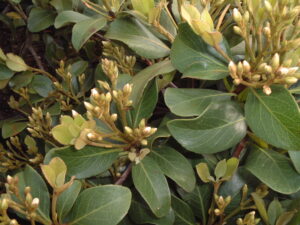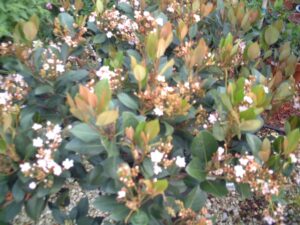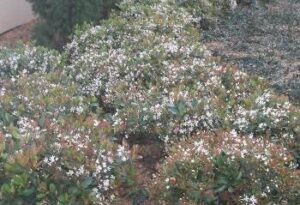S & J Nursery’s Guide to Growing
Indian Hawthorne
Shrubs in the Jacksonville | St. Augustine area Landscape
( Rhaphiolepis Indica Alba )
Indian Hawthorne Origins:
– Native to Southern China
Indian Hawthorne Exposure:
– Indian Hawthorne will thrive in any full sun location and will tolerate some partial shade in our North Florida | Jacksonville | St. Augustine area landscapes, if attempting to plant in a more shaded location take care
to locate Indian Hawthorne shrubs where they will have morning shade and afternoon sun to avoid having the foliage stay unnecessarily wet through the night after hot summer rains.
Indian Hawthorne Foliage:
– Indian Hawthorne’s foliage emerges a reddish tinged green and matures to a nice deep green. The leaves are thick almost leathery in appearance and can range in size up to a few inches in length.
Indian Hawthorne Soil Preference / Salt tolerance:
-Indian Hawthorne is tolerant of a wide range of soil conditions providing they are planted in a well draining location. Do not plant these in flood zones or where water drains slowly after storm rains.
– High salt tolerance makes Indian Hawthorne an excellent landscape choice for the coastal areas of our North Florida landscapes.
 Indian Hawthorne Size Variance:
Indian Hawthorne Size Variance:
– Indian Hawthorne can grow up to 3-5 ft high and 3-5 ft wide although easily kept as low as 2 ft High and 2 ft Wide with just annual pruning.
Indian Hawthorne Growth Habit:
– Indian Hawthorne has a naturally rounded almost dome shaped habit and will require little to no pruning to keep its tidy habit.
Indian Hawthorne Growth Rate:
– Indian Hawthorne grow slowly in the North Florida landscape only adding a 3-6 inches to its height each year.
Indian Hawthorne Bloom:
– Fragrant white clusters of flowers ( almost covering the plants foliage ) on the tips of branches each spring, the floral display each year when these plants are in bloom is very showy, a profusion of flowers year after year
on a low maintenance landscape plant.
– Spring flower display is followed by the set of purplish blue to black berries in the latter part of the summer season and may remain on the plant into the winter season.
Indian Hawthorne Water Requirements:
– Drought tolerant landscape selection once established into the landscape.
Best Uses For Indian Hawthorne in the North  Florida | Jacksonville | St. Augustine area landscape :
Florida | Jacksonville | St. Augustine area landscape :
– Indian Hawthorne makes an excellent choice for a lower plantings around the foundation of homes, commercial buildings or in median areas of parking lots and highways.
– Beautiful accent plant makes the perfect patio or container plant where a well behaved flowering accent is desired. Perfect for coastal entry ways or pool and patio areas. You never have to fuss with them and the fragrant
spring flowers are perfect for up close exposure.
– Low maintenance landscape plant selection!
Care of S & J Nursery’s North Florida | Jacksonville | St. Augustine Shrubs:
– Shrubs can be planted in the North Florida | Jacksonville | St. Augustine area at any time during the year. In normal and well draining soils dig the hole as deep as the root ball and two to three times as wide. Plant the top
of the root ball level or slightly higher than the surrounding soils. When planting in poorly drained soils make sure to plant your shrubs a minimum of 3 inches ABOVE the surrounding soil level.
– Water every day during the establishment period. For most 3 gallon size shrubs in the North Florida landscape in average soil, that is neither heavy clay that holds water or really sandy that will take 2-3 weeks of daily
watering to ensure that your newly planted shrub will begin to put out new roots and grow into its new home happily. After the first few weeks begin tapering back your watering to every other day then every third day and so
on until your newly planted items are flourishing without your assistance.
– If planting larger shrubs you may need to extend the initial care a bit longer to protect your investment and get your shrubs off to the best start possible.
– IMPORTANT: If planting shrubs in heavy clay soils that hold allot of water after a rain or irrigating, remember to check the soil for moisture by sticking your fingers into the soil near the root ball of the newly planted shrub down to 2-3 inches. If it remains wet from the previous watering wait for the top 2-3 inches to dry out before watering again.
– IMPORTANT: When planting shrubs into poor sandy soils be sure to amend the planting hole by mixing compost or cow manure etc. with the native soil that will go back in the hole around the new plants root ball when installing your shrub material, this will not only give your new shrubs good soil to grow its new roots into but help it hold water.
– When planting shrubs from containers be sure to loosen the roots as much as possible pulling loose roots away from the root ball before installing your new plants, if the roots are to tight to easily loosen with your hands
use a knife to cut a few slits into the root ball being careful to go all the way from the top to the bottom and making the cut at least an inch deep. This will ensure that your plant will immediately begin to form new roots
into its new surrounding soil.
– Mulch newly planted shrubs whenever possible.
– Fertilize each spring with a mixture of Milorganite or Green Edge and a slow release poly coated plant food such as Osmocote or Stay Green general purpose plant food, sprinkling the fertilizer around the mulch circle underneath the foliage of the tree
– Prune as needed to shape each spring and or summer.

